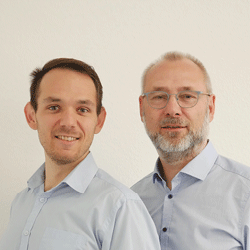
Brochure - Download now
The windream ECM-system is regarded to be the technologically leading solution for capturing, administering and archiving any kind of documents. Learn more about our products, solutions and integrations.
Paper is completely out! Instead of looking for files in the basement, manage your documents only in electronic form. Save time and money with modern ECM software solutions that digitally optimize your business processes and centrally manage your entire corporate knowledge with all information in a common knowledge pool. These are precisely the requirements that a digital enterprise content management (ECM) system fulfills one hundred percent. But that's not all. From classic, electronic document management to workflows and software integrations into your existing IT infrastructure, you can digitally implement all the solutions you need for your company.

The windream ECM-system is regarded to be the technologically leading solution for capturing, administering and archiving any kind of documents. Learn more about our products, solutions and integrations.
"DMS" means "Document Management System". "ECM" is short for "Enterprise Content Management". The terms are often used synonymously, but they differ. But what exactly is the difference? The abbreviation DMS primarily refers to classic document management. Here you mainly manage documents such as typical office files. But also images, videos, audio files and any kind of information that is available as a file can be efficiently managed in a DMS.
In contrast, an enterprise content management system (ECM system) not only stores documents or files, but also includes other applications and the data and information generated from them. These can be e-mails as well as electronic business processes (workflows) or even combinations with other third-party applications such as ERP and other business-relevant applications. "Enterprise Content Management" basically means that you centrally manage your entire corporate knowledge - in other words, the content. All employees in the company access it with different applications, even mobile, depending on their individual authorization. Our windream ECM-system exactly fulfills these requirements.
There are many reasons for using an enterprise content management system (ECM system). Time and thus cost savings as well as a significantly reduced space requirement are the traditional criteria that favor the use of IT-supported systems. The time savings result primarily from the fast archiving of documents and information and the sophisticated retrieval options, which enable you to find the stored information without losing time.
Advantages of an ECM system
Nowadays, it is essential for an enterprise content management system to meet the legal requirements that apply, for example, to retention, provisioning and deletion obligations for companies. Between GoBD and EU-DSGVO, an ECM-software has to consider all legal regulations and implement them accordingly. Therefore, we have had our windream ECM-system checked by an independent authority. An expert opinion confirms that our ECM-system fully complies with all legal requirements.
Searching for archived information is a central criteria that every ECM system must fulfill. For this purpose, modern ECM software provides you with various methods. For example, a full-text search, which can be performed by simply entering a single keyword. Other options include a quick search, a research with the help of search operators or an intelligent search with assistants that efficiently support you in complex searches. If you want to perform certain searches for documents and information repeatedly, it should be possible to save the search terms and repeatedly retrieve them later, so that you do not have to re-enter them.
Modern ECM systems can virtually reproduce file structures as in a traditional file archive. Create, sort, move or add to digital files and their contents according to your individual ideas and exactly as required for your personal work in the company. With electronically managed "digital files", you discover completely new possibilities for efficient file management.
With solutions for digital business process modeling (Business Process Management, BPM), you are able to digitally map and execute typical processes in your company. An enterprise content management system should therefore be able to link documents with processes, also called workflows, if required. In most cases, workflows are accompanied by important documents. It must therefore be ensured that solutions for process modeling can be linked to the ECM system.
Mobile working and thus location- and time-independent access to documents is becoming increasingly important. Mobile devices such as smartphones and tablets are increasingly replacing traditional desktop PCs and notebooks. Ensure that your employees can access and edit documents, information and workflows on any device at the company site, in the home office and also while being on the road. And this without restricting the ECM functions.
Mobile Working
The possibility of connecting an ECM system to third-party applications such as ERP or CRM systems is always helpful and makes sense. Especially if you are already operating an infrastructure with various applications (which is to be assumed, of course), you should check whether an enterprise content management system can be integrated with other applications. After all, such integration will always lead to a significantly higher degree of automation, since the software systems can exchange data with each other. In this way, you can ultimately transfer data from third-party applications into your "knowledge pool".
Everything used to be on paper? - Not really. Because electronic or digital systems for information management have been available for ages, or at least for decades. But how has this all actually developed?
Electronic archives have been available worldwide for many years in a wide variety of application areas. Back then - around the 1980s - they were considered large-volume data stores that users could access via specific network structures. A central archive was accessed by so-called archive clients. For this purpose, client software had to be installed on the individual workstations - the computers - via an archive search could be carried out. But that was it. At that time, no one was talking about uploads and downloads or other convenient functions for processing digital documents.
This changed with the classic systems for "real" document management, around the early nineties of the last century. These systems are still called "document management systems" or in short simply DMS. In contrast to the simple archives, extensive innovations were added, which these systems offer to the user in companies (DMS is still a big topic within information technology). The new components included functions such as storing digital documents directly from an IT workstation or working with and exchanging digital documents directly on a server via a network. And Web portals even make it possible to perform document management functions directly via an Internet browser, without client installation.
Other useful functions were added, for example:
During this evolutionary phase, the concept of a document was also redefined. Today, documents are not only Office documents such as Word or Excel files, but also all information that can be stored in the form of a file in a DMS or archive. This can also include audio files, films, photos or drawings, as well as any other information that can be stored as a file on a DMS server
But the development went even further. DMS became ECM. "Enterprise Content Management" expands the concept of classic document management once again and means that an ECM system can also include e-mail archiving, for example. Alternatively, users can transfer data from third-party applications into their ECM system and - at best - completely integrate one or more specialist applications into their ECM software.
The basic idea in the context of Enterprise Content Management (ECM) is actually always to create a central data pool in which the entire corporate knowledge is stored and managed in a central location. In principle, it does not matter from which application in the company the data originates. For example, data can be exported from financial accounting or an ERP system and stored in an ECM system. The reverse is also possible, for example, when the ECM software transfers documents to a third-party application.
Get to know the windream ECM-system
But even Enterprise Content Management (ECM) was not the end of the story. An increasingly dynamic working world led to ECM being perceived more and more in the context of a more global IT infrastructure. It should make it possible for business processes in companies to be controlled and handled much more efficiently; as quickly as the modern business world requires. Among other things, this led to the integration of BPM-systems (BPM = Business Process Management) into ECM-systems, as it is the case with windream. The advantages: Business processes can be handled much faster in companies with electronic workflows than it would be the case with a "manual" management. But there is another aspect. In the context of an ECM system, workflows are linked to process-accompanying documents. This means that not only the actual workflow is digitally mapped, but the workflow can also supply all documents and information that are important for the process or for the users involved, if required. This is no longer a matter of archiving statically, but of dynamically running processes with extremely efficient handling.
Workflow-Automation
Another aspect of this development stage is - and this is meant quite literally - problem solving. According to the slogan: "I have a problem - how can I solve it?" there are numerous software systems that define themselves as problem solvers. Examples are numerous:
At the moment, the last one is perhaps THE hot topic. However, we are not talking about the creation and maintenance of digital files in general. Modern ECM-systems like windream are even able to present a customized solution to certain industries. At this point, we will only mention the highly specialized software for the management of construction files as an example.
As a logical further development of this entire evolutionary process, windream GmbH has presented an ECM-software for the first time in 2020 which can definitely be called the IT-workspace of the future. With windream and the windream Dynamic Workspace, the company presents for the first time an ECM-software with integrated information management, classic DMS, (enterprise) content management, business process modeling via workflows, specialist applications as well as software solutions under one common roof. Uniform, clearly arranged and also for mobile use on different end devices.
Advantages of windream Dynamic Workspace
We will be happy to advise you personally on our digitization solutions!
Stay up-to-date and subscribe to our windream newsletter now.

Mon to Fri 8.30 a.m. to 5.30 p.m.